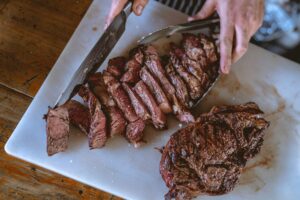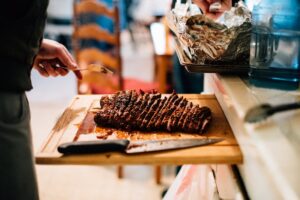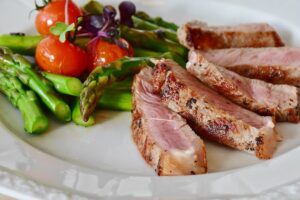Each beef cut is named based on where it comes from on the cow. Moreover, people who love beef have their favorite recipes for almost every cut.

Two main cuts from the cow include top sirloin and London broil, each with a delicious taste. Still, some folks wonder if they’re the same thing.
In this article, we’ll simplify the confusion by providing a straightforward comparison of top sirloin vs London broil. Before we dive into the details, let’s learn more about each cut.
Is a Top Sirloin the Same As a London Broil?
The sirloin cut comes from the rear part of the cow and is commonly enjoyed as steaks. It’s extracted from the sirloin area near the short loin, giving rise to popular cuts like porterhouse, T-bones, and club steaks.
The sirloin is divided into boneless sections—the upper sirloin butt and the lower sirloin butt.
Slicing along the natural seam, from the upper sirloin to the sirloin tip and knuckle, results in two sections, with the top part being the most tender and flavorful due to the muscles getting lean and tough through exercise.
On the other hand, London broil isn’t a specific cut but rather a dish made from top-round or flank steak. The cooking style, involving marinating and broiling, is so popular that the top round is often labeled as London broil.
Both top-round London broil and flank steak cost less than sirloin but tougher. The top round, taken from the leg and rump, is favored for roasting, gaining leanness and flavor from well-exercised muscles.
Pay attention when purchasing London broil, as they often sell both top round and flank steak under this name. Flank steak from the lower chest area is lean and tasty but significantly tougher than sirloin.
Top Sirloin vs London Broil: What’s the Difference?
The key difference between these steak cuts lies in the richness of flavor. Sirloin, a highly flavorful piece, is sourced from one of the cow’s most tender areas.
On the other hand, London broil isn’t a steak cut; it’s a round or flank cut with inherent flavors that require unlocking through softening or tenderizing.
Now that we’ve highlighted the main difference between sirloin steak and London broils let’s delve into other distinctions.
1. Tenderness
Sirloin steak offers excellent value for money, sitting comfortably in the mid-range with tenderness and flavor comparable to more expensive cuts.
The top sirloin butt cuts are particularly tender, rivaling pricier options like short loin, New York strip, and ribeye in softness.
However, the bottom sirloin butt cuts can be tougher, akin to flank steak. Despite chewiness and noticeable marbling, proper preparation through roasting, broiling, or thorough cooking ensures a flavorful outcome.
On the other hand, London broil cuts, often chosen for budget-conscious families, cost less. While the price is great, these cuts require careful cooking to bring out their full flavor.
Both flank steak and top round, used for London broil, are sinuous and need roasting or marinating to enhance their bold flavor and achieve a degree of softness.
However, being tougher cuts, London broil isn’t suitable for high-temperature grilling or frying. The leanness necessitates close monitoring to prevent overcooking.
2. Flavor

Sirloin cuts deliver a deep, beefy flavor across the board, and slow-roasting bottom sirloin enhances these flavors even further.
However, with flank steak, there’s a trade-off—while it may not be as tender, it offers a strong, boldly beefy flavor that can be a flavorful alternative.
3. Size
Sirloin steaks are moderately thick, averaging around 9 ounces each, while prime rib and ribeye are typically larger at about 12 ounces. Sirloin steaks generally range in thickness from three-quarters of an inch to one-and-a-quarter inches.
On the other hand, flank steak, commonly used for London broil, is cut between 4 and 8 inches long and is under an inch thick.
In contrast, a top-round cut specifically for London broil and flank steak prepared for broiling by a butcher is cut to 12 inches long and 2 inches thick.
4. Nutrition
A typical top cut of sirloin steak provides 30.8 grams of protein and 5 grams of fat per portion. A 3.5-ounce serving of sirloin top butt also offers approximately 25% of the daily value of vitamin B6, 23% cobalamin, 8% iron, 1% calcium, 1% vitamin D, and 4% magnesium.
In comparison, bottom cuts of sirloin deliver 26.5 grams of protein and 8.3 grams of fat, along with similar vitamin and mineral content at 182 calories.
For a 100-gram standard serving of top round, you get 7 grams of fat, 28 grams of protein, 363mg potassium, 77mg cholesterol, and fulfill 35% of the daily value for vitamin B6, 66% cobalamin, 16% Iron, and 6% magnesium, all within just 182 calories.
5. Serving Suggestions
For sirloin top butt cuts, scorching high heat for a short period is ideal to avoid toughness. On the other hand, sirloin bottom butt cuts shine when marinated and roasted or broiled.
Flank and top rounds are excellent choices for marinating, roasting, or broiling, resulting in juicy and flavorful outcomes, perfect for soups and stews. Additionally, both cuts can be utilized for ground meat preparations.
6. Presentation

Sirloin steaks, with their moderate thickness, often have a substantial and hearty appearance on the plate. On the other hand, London broil, being thinner, may have a more elongated and leaner look when served.
So, it’s not just about the taste and tenderness but also about the visual appeal on your dinner table.
7. Price
In the US, top sirloin steak typically costs between $6 to $8 per pound, while bottom sirloin steak is priced between $5 to $6 per pound. For top-round and flank steak, you can expect to pay approximately $4.50 to $7 per pound.
What Is the Difference Between London Broil and Top Round?
The terms London broil and top round, although related, refer to different things.
“London broil” is actually a cooking method rather than a specific cut of meat. It typically involves marinating and broiling a flank steak or top-round steak.
The term “London broil” has become so popular that it’s often used to label the top round cut itself.
On the other hand, “top round” is a specific cut of beef. It comes from the hindquarters of the cow and is a lean and less tender cut.
When labeled as London broil, the top round is often prepared using the marinating and broiling method for better flavor and tenderness.
So, in summary, London broil is a cooking method, and the top round is a cut of meat that’s commonly used for London broil preparation.
Top Sirloin vs London Broil: Conclusion
In conclusion, when dealing with London broil steaks, thorough marination is key, especially for more muscular cuts that require time to absorb the flavors.
Experiment with acidic but low-sodium marinating ingredients to ensure tenderness without compromising the taste.
On the other hand, if you choose sirloin, they don’t require much time to tenderize—just a few minutes to stand after a sprinkle of salt and pepper.
It’s important to note that London broil takes significantly longer to prepare than sirloin, so factor this in when deciding on your meat choice.
